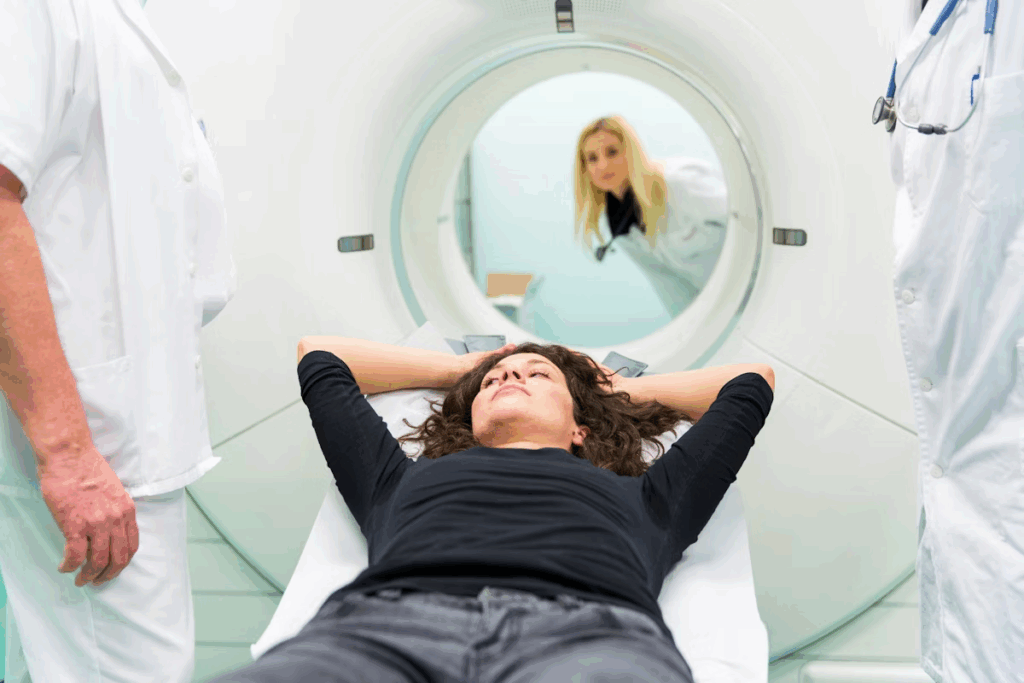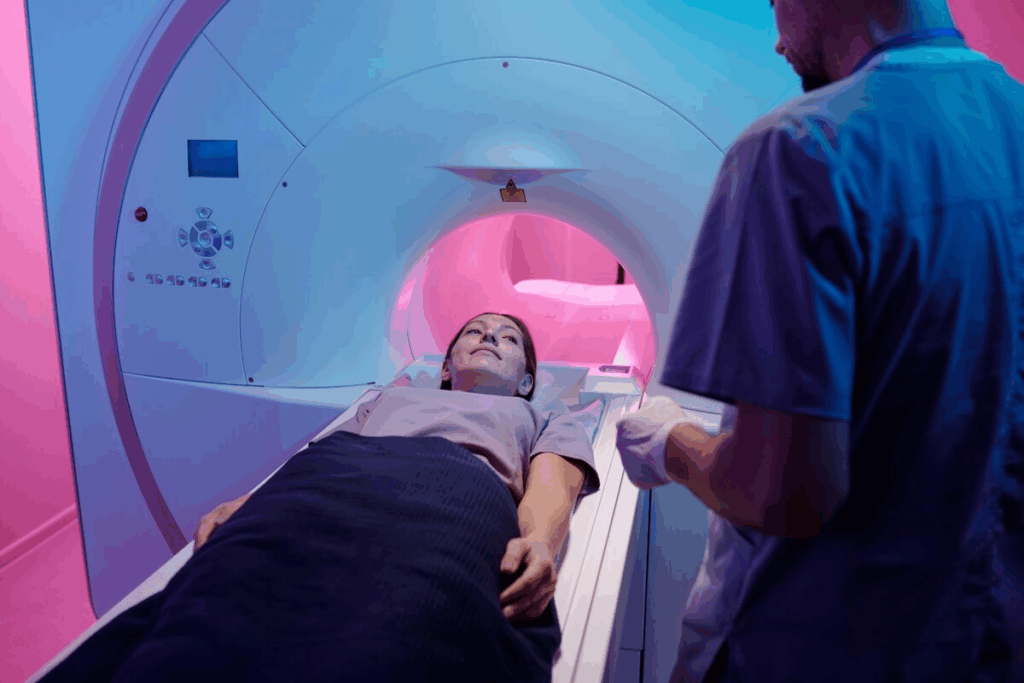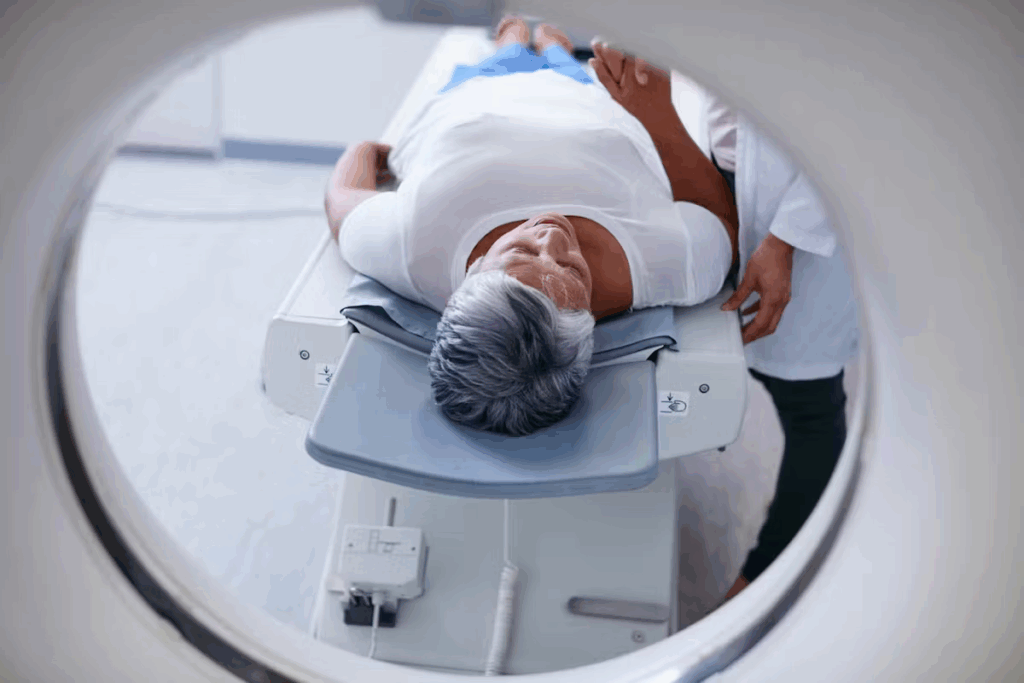Last Updated on October 21, 2025 by mcelik

Every year, over 2 million PET scans are done in the United States. They are key in diagnosing and treating many health issues. PET scans are vital in healthcare, helping doctors see how serious a disease is and if treatments are working.
It’s important for both patients and doctors to know the healthcare protocols for PET scans. How often you get a PET scan depends on your health and the disease being treated.
There are specific clinical guidelines for PET scans. It’s important to follow these to make sure PET scans are used safely and effectively.

Positron Emission Tomography (PET) scans are key in today’s medicine. They are a detailed imaging method for diagnosing and tracking health issues. They give insights into how the body’s cells work.
A PET scan uses a tiny amount of radioactive tracer to see how the body works. The tracer goes into the body’s tissues and organs. The PET scanner picks up signals from the tracer to make clear images.
PET scans are used for many health issues, including:
PET scans are different from CT scans and MRI. While CT scans show body structure, PET scans reveal metabolic activity. For example, in cancer, PET scans spot high activity areas, which might mean tumors.
Knowing how PET scans work helps patients and doctors make better choices for health care.

PET scans are becoming more common. It’s important to know about their radiation risks. These scans use small amounts of radioactive tracers to help diagnose and monitor health conditions.
The radiation from PET scans is measured by the “effective dose.” This dose shows how much radiation the body absorbs. It’s measured in millisieverts (mSv) and considers how different parts of the body react to radiation.
Several factors affect the effective dose from PET scans:
To understand PET scan radiation better, let’s compare it to other sources. For example:
Knowing these comparisons helps patients and doctors make better choices about PET scans.
Repeated PET scans can lead to cumulative radiation effects. While the body can repair some damage from low doses of radiation, too much can cause harm over time.
Several factors affect cumulative radiation effects:
Doctors must consider these factors when deciding how often to use PET scans on patients.
It’s key for patients and doctors to know the official PET scan frequency guidelines. These rules help make sure PET scans are used right and safely.
The FDA gives guidelines on safe PET scan use, including radiation dose limits. They don’t set a specific limit on scan numbers. But, they stress the need to justify each scan for medical reasons.
The American College of Radiology (ACR) has detailed PET scan use guidelines. Their Appropriateness Criteria help decide when PET scans are right for different health issues.
The International Commission on Radiological Protection (ICRP) sets global radiation protection standards. They suggest keeping medical exposures low while keeping quality high.
Various groups offer different PET scan frequency advice. For example:
These guidelines help us understand safe PET scan practices. By following them, doctors can use PET scans wisely and safely for patients.
Guidelines for PET scans are based on each patient’s needs. They consider several important factors. These help ensure the scans are safe and effective.
Doctors look at many things when deciding how often a PET scan is safe. They check the patient’s health and medical history. This helps balance the scan’s benefits and risks.
Age is a big factor in PET scan frequency. Children and adolescents are more vulnerable to radiation. Adults, including the elderly, have different considerations based on their health.
For kids, the risks of radiation are carefully weighed. Doctors might use other imaging methods or adjust the dose of the radiopharmaceutical.
The severity of a patient’s condition is key. Those with aggressive or advanced diseases might need more scans. This helps track how well treatments are working.
For less severe conditions or when the disease is in remission, scans can be less frequent. This reduces radiation exposure while keeping an eye on the condition.
A patient’s overall health is very important. Those with multiple comorbidities or weakened immune systems may need special imaging plans.
It’s important to consider any past radiation exposure. The total dose of radiation is tracked to keep it safe.
“The goal is to achieve a balance between obtaining necessary diagnostic information and minimizing radiation exposure to the patient.”
Radiological Society of North America
Doctors use this info to decide on future PET scan frequencies. They adjust as needed to keep patients safe.
PET scans are key in managing cancer, from start to finish. How often they’re used depends on the cancer type, its stage, and the treatment plan.
At first, PET scans help figure out how far cancer has spread. They follow medical best practices to:
In lymphoma, PET scans are very helpful. They help see how far the disease has spread and where to take biopsies.
During treatment, PET scans check if the cancer is responding well. This is key for:
Oncologists say PET scans are vital. They show how active tumors are, helping tell alive tissue from dead tissue after treatment.
After treatment ends, PET scans watch for cancer coming back. How often they’re done depends on:
For aggressive cancers, more scans might be needed.
Each cancer type has its own PET scan schedule. For example:
“For stage III melanoma patients, PET scans are often used regularly to watch for cancer coming back.”
Guidelines say PET scan frequency should match the patient’s risk and treatment plan.
PET scans are key in managing neurological disorders. They help track disease progress and check how well treatments work. The scan’s frequency depends on the disorder type, its severity, the patient’s age, and health.
PET scans are vital for Alzheimer’s and dementia patients. They help track the disease’s progress and check treatment success. Clinical guidelines suggest PET scans every 12 to 24 months, based on the patient’s condition and treatment response.
PET scans are used in epilepsy management to find seizure foci and check brain activity. The scan frequency varies with the case’s complexity and treatment plan.
Healthcare protocols suggest that for patients with refractory epilepsy, PET scans may be done every 1-2 years or as needed for surgical planning or treatment adjustment.
PET scans are critical for brain tumor patients to monitor treatment response and detect recurrence. The scan frequency depends on the tumor type, grade, and treatment.
PET scans help assess dopamine function and track Parkinson’s disease progression. They are not as common as in other conditions but offer valuable insights for advanced Parkinson’s management.
PET scans are mainly used when there’s uncertainty in diagnosis or when evaluating advanced therapies.
PET scans are key in cardiology. They help doctors check the heart and make smart choices. How often to use PET scans depends on the heart issue and the patient’s health.
PET scans are great for coronary artery disease (CAD). They check how well the heart gets blood and if it’s working. Evidence-based guidelines say PET scans help find who needs heart procedures.
“PET imaging is a big help for heart disease,” say medical guidelines. It spots blood flow problems and helps doctors make better choices. This leads to better care for patients.
PET scans are also good for checking if heart muscle can recover. This is key for those with heart problems. Studies show that if the heart muscle is alive, treatments work better.
After heart surgeries, PET scans check if the heart is working right. How often depends on the patient’s health and the surgery done.
PET scans are useful for heart sarcoidosis. They help see how active the disease is and guide treatment. Medical guidelines suggest using PET scans to see how much the heart is affected and if treatment is working.
In short, the right use of PET scans for heart issues depends on the patient. Following evidence-based medical guidelines helps doctors use PET scans wisely. This leads to better care and fewer risks for patients.
Getting insurance for multiple PET scans can be tough. Patients and doctors need to know about healthcare policies and patient care to get the right coverage.
Medicare covers PET scans under certain conditions. It usually covers scans for cancer diagnosis and treatment checks. But, getting coverage for more than one scan depends on if it’s medically needed.
Key aspects of Medicare coverage include:
Private insurance plans differ in PET scan coverage. Some offer more, while others are more limited.
Factors influencing private insurance coverage include:
If an insurance claim for a PET scan is denied, patients can appeal. They need to send more info to show the scan’s medical needs.
“Patients should be prepared to provide detailed medical records and a letter of medical necessity from their healthcare provider to support their appeal.”
For patients needing multiple PET scans, detailed records are key. This includes:
Knowing about insurance for multiple PET scans is vital. It helps patients get the care they need without big costs.
PET technology is evolving, making medical imaging safer. New developments aim to lower radiation while keeping image quality high. This could mean more PET scans can be safely done.
New PET scanners are more sensitive and clear. They need lower doses of radiopharmaceuticals to get great images. Some scanners can cut the dose by up to 50% compared to old ones.
The amount of radiopharmaceutical in PET scans is being fine-tuned. Using lower doses reduces patient radiation exposure. This is key for those needing many scans over time.
Digital PET tech offers better sensitivity and clarity than old scanners. It allows for better image quality at lower doses. This makes it safer for patients to have more scans if needed.
New low-dose PET tech might change how many scans patients can safely have yearly. As these techs spread, medical practice standards could update. This reflects the lower risks with less radiation.
Healthcare providers can make better choices with these techs. They could lead to better patient care through more accurate and frequent scans.
Healthcare professionals must weigh the benefits and risks of PET scans. They aim to give patients the right info while keeping radiation low. This balance is key, more so for conditions needing repeated scans.
When deciding on PET scan frequency, a detailed analysis is needed. It compares the scan’s benefits to the radiation risks. Factors include the patient’s health, age, and past radiation exposure.
Doctors are key in deciding when and how often to use PET scans. They follow healthcare recommendations and medical protocols to give the best care.
They base their decisions on the patient’s health, symptoms, and past tests.
Patient advocacy and informed consent are vital. Patients need to know the scan’s benefits and risks, including radiation.
Ethical issues with repeat PET scans are complex. Healthcare providers must weigh accurate diagnoses against radiation risks. They must also respect patient autonomy and informed choice.
Important ethical points include reducing radiation, informing patients fully, and following medical protocols and healthcare recommendations.
To cut down on PET scans, we need to look at other imaging choices. These options can give us similar or extra info for diagnosing and tracking health. With new tech, many alternatives are now good for finding and watching medical issues.
Magnetic Resonance Imaging (MRI) is a strong tool that can replace PET scans. It shows detailed images of soft tissues without using harmful radiation.A radiologist says, “MRI is key in our toolkit, giving us clear images that often mean we don’t need PET scans.”
Here are some uses of MRI:
Computed Tomography (CT) scans can also act as a substitute or addition to PET scans. They use radiation but give fast, detailed views of inside the body. An imaging specialist, points out, “CT scans are great in emergencies and for those who can’t have MRI.”
CT scans are used for:
Ultrasound uses sound waves to make images of the inside body. It’s great for:
The American Journal of Roentgenology says, “Ultrasound is safe and works well, helping us avoid more invasive or radiation-based methods.”
New imaging tech is always coming out, which might lessen our need for PET scans. Some examples are:
As these new techs get better, they could give us more options than PET scans. This could mean we use PET scans less often but keep getting accurate results.
In summary, there are many other imaging ways that might cut down on PET scans. Knowing what each method does best helps doctors choose the best imaging for their patients.
Using PET scans on vulnerable groups needs careful thought. We must weigh the benefits against the risks. Medical rules help decide how often to use PET scans on these groups.
Kids need special care because their bodies are growing and they’re more sensitive to radiation. Doctors say PET scans on kids should only happen when really needed. They also try to use the least amount of radiation possible.
“The principle of ALARA (As Low As Reasonably Achievable) should be applied to ensure that the lowest necessary dose of radiation is used,” as stated in pediatric radiology guidelines.
Pregnant women also need careful consideration. The risks to both mom and baby must be balanced against the scan’s benefits. Health guidelines say to avoid PET scans unless absolutely necessary.
Older patients often have complex health issues. Age alone doesn’t mean they can’t have a PET scan. Their overall health and the scan’s benefits guide the decision.
People with weakened immune systems, like those with HIV/AIDS or on chemotherapy, might need PET scans. The scan’s frequency depends on their health needs and how it could affect their treatment.
In summary, the use of PET scans on vulnerable groups must consider their health, medical condition, and risks. Following medical rules helps doctors use PET scans wisely and effectively.
Knowing when to get a PET scan is key for good medical care. Patients and doctors should look at clinical practice guidelines and health needs. This helps decide when to use PET scans.
Medical experts say it’s important to weigh the good of PET scans against the risks, like radiation. The FDA and American College of Radiology have rules to help figure out safe scan times.
Things like how old you are, how serious your illness is, and your overall health matter a lot. Following medical best practices helps doctors give the best care.
Deciding on PET scan frequency needs teamwork between patients and doctors. Knowing the ups and downs of PET scans and following clinical practice guidelines helps get the right care for each person.
There’s no set limit on how many PET scans you can have each year. It depends on your health needs and how severe your condition is. Also, it follows medical guidelines and your insurance policy.
The timing of PET scans for cancer monitoring varies. It depends on the type of cancer, how well it responds to treatment, and your overall health. PET scans are often used at the start, to check treatment progress, and during follow-up. The exact timing is based on specific cancer guidelines and medical practices.
Yes, many medical groups, like the FDA and American College of Radiology, have guidelines. They focus on safe use, including radiation exposure and long-term effects.
PET scans do involve radiation, measured in effective doses. They might expose you to more radiation than ultrasound but could be similar to or less than some CT scans. This depends on the specific scan protocols.
For neurological conditions like Alzheimer’s or brain tumors, PET scan frequency varies. It depends on the condition’s severity and your health. Scans can be repeated as needed to track disease or treatment progress.
Insurance for multiple PET scans varies by policy and provider. Medicare and private insurers have different rules. They often require proof of medical need for more than one scan.
Yes, other imaging like MRI, CT scans, and ultrasound might replace PET scans for some conditions. New technologies are also being explored as alternatives.
New PET technologies, like low-dose scanning, could lower radiation exposure. This might change how often PET scans are done. It could also lead to updates in guidelines.
Yes, kids, pregnant women, older adults, and those with weakened immune systems need extra care with PET scans. Their risk from radiation is higher, so scans are carefully considered.
Doctors weigh the benefits of PET scans against the risks of radiation. This helps decide how often scans are needed for each patient. It’s a careful balance.
Subscribe to our e-newsletter to stay informed about the latest innovations in the world of health and exclusive offers!
WhatsApp us